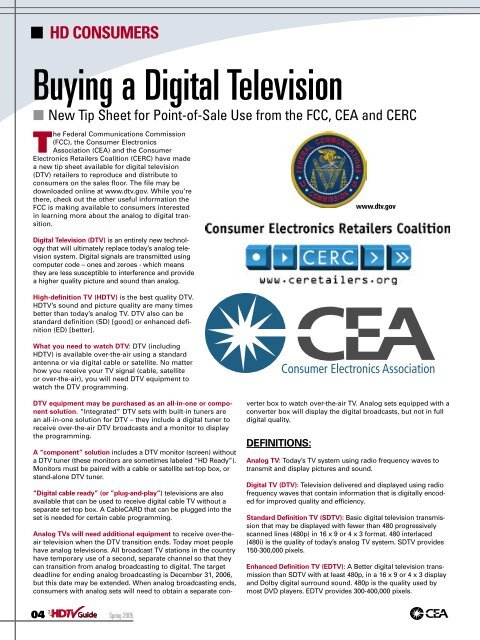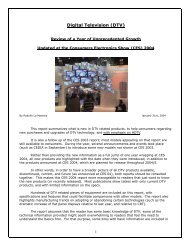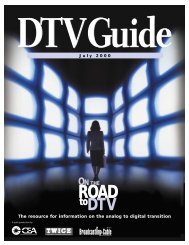Create successful ePaper yourself
Turn your PDF publications into a flip-book with our unique Google optimized e-Paper software.
■ HD CONSUMERS<br />
Buying a Digital Television<br />
■ New Tip Sheet for Point-of-Sale Use from the FCC, CEA and CERC<br />
T<br />
he Federal Communications Commission<br />
(FCC), the Consumer Electronics<br />
Association (CEA) and the Consumer<br />
Electronics Retailers Coalition (CERC) have made<br />
a new tip sheet available for digital television<br />
(DTV) retailers to reproduce and distribute to<br />
consumers on the sales floor. The file may be<br />
downloaded online at www.<strong>dtv</strong>.gov. While you’re<br />
there, check out the other useful information the<br />
FCC is making available to consumers interested<br />
in learning more about the analog to digital transition.<br />
Digital Television (DTV) is an entirely new technology<br />
that will ultimately replace today’s analog television<br />
system. Digital signals are transmitted using<br />
computer code – ones and zeroes - which means<br />
they are less susceptible to interference and provide<br />
a higher quality picture and sound than analog.<br />
High-definition TV (<strong>HDTV</strong>) is the best quality DTV.<br />
<strong>HDTV</strong>’s sound and picture quality are many times<br />
better than today’s analog TV. DTV also can be<br />
standard definition (SD) [good] or enhanced definition<br />
(ED) [better].<br />
What you need to watch DTV: DTV (including<br />
<strong>HDTV</strong>) is available over-the-air using a standard<br />
antenna or via digital cable or satellite. No matter<br />
how you receive your TV signal (cable, satellite<br />
or over-the-air), you will need DTV equipment to<br />
watch the DTV programming.<br />
www.<strong>dtv</strong>.gov<br />
DTV equipment may be purchased as an all-in-one or component<br />
solution. “Integrated” DTV sets with built-in tuners are<br />
an all-in-one solution for DTV – they include a digital tuner to<br />
receive over-the-air DTV broadcasts and a monitor to display<br />
the programming.<br />
A “component” solution includes a DTV monitor (screen) without<br />
a DTV tuner (these monitors are sometimes labeled “HD Ready”).<br />
Monitors must be paired with a cable or satellite set-top box, or<br />
stand-alone DTV tuner.<br />
“Digital cable ready” (or ”plug-and-play”) televisions are also<br />
available that can be used to receive digital cable TV without a<br />
separate set-top box. A CableCARD that can be plugged into the<br />
set is needed for certain cable programming.<br />
Analog TVs will need additional equipment to receive over-theair<br />
television when the DTV transition ends. Today most people<br />
have analog televisions. All broadcast TV stations in the country<br />
have temporary use of a second, separate channel so that they<br />
can transition from analog broadcasting to digital. The target<br />
deadline for ending analog broadcasting is December 31, 2006,<br />
but this date may be extended. When analog broadcasting ends,<br />
consumers with analog sets will need to obtain a separate converter<br />
box to watch over-the-air TV. Analog sets equipped with a<br />
converter box will display the digital broadcasts, but not in full<br />
digital quality.<br />
DEFINITIONS:<br />
Analog TV: Today’s TV system using radio frequency waves to<br />
transmit and display pictures and sound.<br />
Digital TV (DTV): Television delivered and displayed using radio<br />
frequency waves that contain information that is digitally encoded<br />
for improved quality and efficiency.<br />
Standard Definition TV (SDTV): Basic digital television transmission<br />
that may be displayed with fewer than 480 progressively<br />
scanned lines (480p) in 16 x 9 or 4 x 3 format. 480 interlaced<br />
(480i) is the quality of today’s analog TV system. SDTV provides<br />
150-300,000 pixels.<br />
Enhanced Definition TV (EDTV): A Better digital television transmission<br />
than SDTV with at least 480p, in a 16 x 9 or 4 x 3 display<br />
and Dolby digital surround sound. 480p is the quality used by<br />
most DVD players. EDTV provides 300-400,000 pixels.<br />
04 Spring 2005








